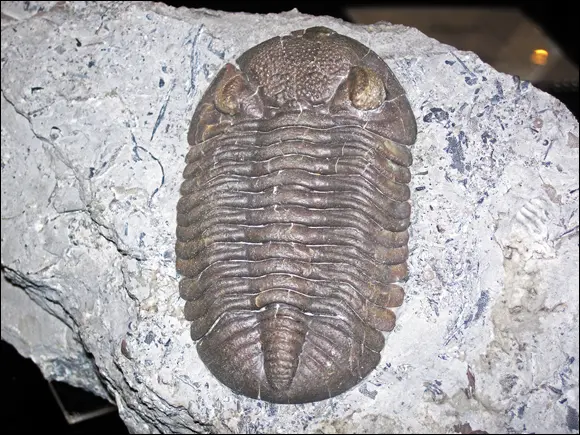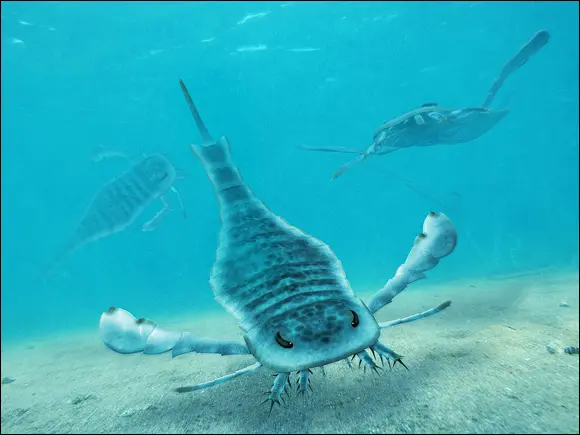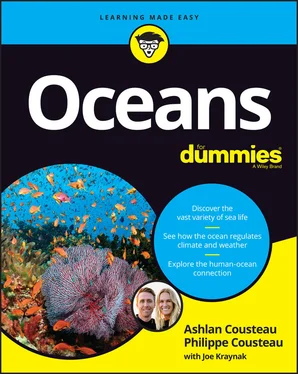How the first multicellular organisms developed and then how more complex organisms developed with distinct organs and limbs are topics of speculation. What we do know is that the first multicellular organisms arrived on stage — about 600 million years ago, which is relatively recent in the ocean’s 3.8 billion-year history.
Multicellular life really took off in the Ediacaran period (from 635 to 541 million years ago) with simple organisms such as branching rangeomorphs (animals shaped like leaves), the kimberella (sort of like a slug), and the spriggina (similar to a trilobite; see Figure 3-1), as well as early sponges and cnidarians (jellyfish, anemones, and so on), and soft-bodied organisms that looked like worms, corals, sea-pens, seaweed, and lichen. Dickinsonia is another famous organism from this period, and may be the first animal to move on its own, scampering across the seafloor some 567 to 550 million years ago. Some of these may be the first metazoans — animals with specialized cells and different body sections for different roles.

Photo by James St. John. Licensed under CC BY 4.0.
FIGURE 3-1:Trilobite fossil.
Taking evolution to the next level in the Paleozoic era
Buckle up, folks … this is where things start to get really interesting. Don’t be turned off by the hard-to-pronounce words or events that can be a little confusing (we had to study this many times before it sunk in). This section begins the story of the evolution of complex life-forms on Earth, and it is a fascinating one. If anything, it reminds us of the incredible dynamism and complex wonder that resulted in … well … us. So read on and marvel at just how amazing this world really is.
The Paleozoic era spans from about 541 to 251 million years ago, when life underwent enormous diversification. ( Paleozoic roughly translates to “ancient life.”) It began with the Cambrian explosion (when nearly all major animal phyla appeared) and ended with The Great Dying (a mass extinction) and can be subdivided into the Cambrian, Ordovician, Silurian, Devonian, Carboniferous, and Permian periods.
The Cambrian period (from 541 to 485.4 million years ago) was a time of massive diversification of life in the ocean. It was thought to have begun as a result of changing ocean chemistry (due to erosion and minerals washing into the ocean) and a boom in oxygen levels due to growing populations of phytoplankton (see Chapters 7and 8for more about phytoplankton). During this period:
Shells and exoskeletons with new body plans evolved.
The first complex animals with mineralized remains formed.
The evolution of flexible limbs became the first “arms.”
The first real predators evolved, such as anomalocaris, a shrimplike creature that hunted worms and other soft bodied animals.
Pikaia (see Figure 3-2) and haikouella grew a flexible rod of cartilage to swim, becoming the ancestors of the vertebrates (animals with backbones).
Trilobites, one of the first arthropods (think spider or crab), appeared.
More complex food webs began to develop.
This period ended with the Cambrian-Ordovician Extinction event, due to a possible crash in oxygen levels in the ocean.

Photo by Nobu Tamura. Licensed under CC BY-SA 2.0
FIGURE 3-2:Artist rendering of a Pikaia with a jellyfish.
The Ordovician period (from 485.4 to 443.8 million years ago) changed the face of the world. Rapid seafloor spreading resulted in high sea levels, creating new environments and habitats as well as a rapid diversification of life, including the Great Ordovician Biodiversification event. During this period:
True fish appeared (see Chapter 12), the ostracoderms — jawless fish with bony plates.
Ocean life also consisted of graptolites (which lived in colonies sharing the same skeleton), corals, crinoids (think starfish, sea urchins), brachiopods (clams, oysters), the surviving trilobites, gastropods (snails, slugs), cephalopods (squid, octopus), and red and green algae.
Also swimming around during this period are six-meter-long shelled cephalopods called cameroceras (imagine a squid in a long pointy shell, three times longer than you are tall).
The first land plants started to grow, resembling moss. These plants sucked up a lot of carbon dioxide helping to create an ice age, which is basically the opposite of what is happening now — global warming as a result of a massive release of greenhouse gasses, including carbon dioxide (thanks to human activities).
The Ordovician-Silurian Extinction event occurred, wiping out 86 percent of marine species, including some trilobites and cephalopods. (These periods never seem to end well.)
The Silurian period (from 443.8 to 419.4 million years ago) was a time of stable climate (well, relative to earlier periods), but warmer, causing sea levels to rise again. So fun. During this period:
Early vascular plants appear, and fungi move onto land. This is also possibly when spiders and centipedes show up.
Fish split into bony fish and cartilaginous fish. The cartilaginous fish eventually become sharks and rays.
The bony fish split into two groups — lobe-finned and ray-finned. The ray-finned fish give rise to modern fish, while the lobe-finned fish evolve into tetrapods (generally four-limbed creatures), which later evolve into amphibians, reptiles, mammals, and birds.
The first evidence appears showing coral reefs expanding and developing.
Brachiopods (like oysters) are very common, but other organisms continue to thrive, including trilobites, echinoderms, cephalopods, and gastropods.
Ostracoderms (jawless fish) diversify, and the first freshwater species evolves.
Sea scorpions called eurypterids (sort of like horseshoe crabs) evolve, and holy moly are they ever terrifying! (See Figure 3-3.)
Fish get jaws, although it will be about 430 million more years before Jaws , the book and movie, become popular entertainment.

Photo by Obsidian Soul with background by Dimitris Siskopoulos. Licensed under the CC BY 4.0.
FIGURE 3-3:Artist rendition of a sea scorpion (eurypterid).
The Silurian period ended in a series of smaller extinction events, likely caused by a drop in sea-level, which the bottom-dwellers couldn’t handle; mostly cephalopods went extinct.
The Devonian period (from 419.2 to 358.9 million years ago) marks the era when fish took over the seas. Sea levels were higher, covering much of the land, creating vast shallow coastal areas. During this period:
Common animals are rugose corals, crinoids, and jawless fish.
Early sharks emerge (hey girl, hey!)
Placoderms (jawed, armored fish) dominate and occupy both sea and freshwater environments. Some are predators, others are filter feeders.
Lobe-finned fish relatives develop the ability to move along shorelines (on land), like mudskippers today. 379 million years ago, their descendants finally became land dwellers — tetrapods (meaning four legs). The proof? They left footprints.
Читать дальше















